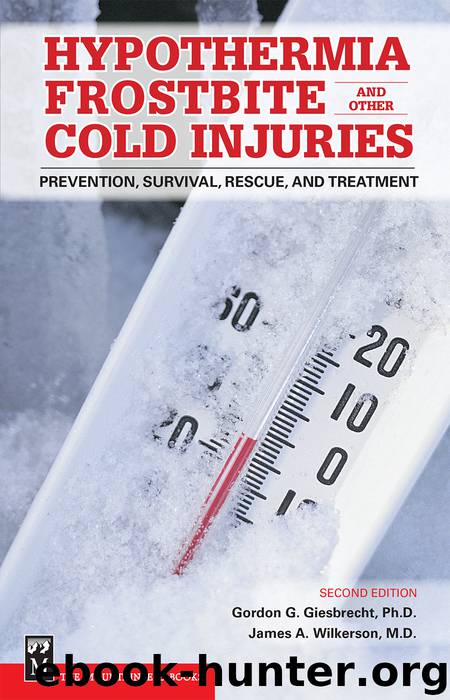Hypothermia, Frostbite and Other Cold Injuries by Gordon Giesbrecht

Author:Gordon Giesbrecht
Language: eng
Format: epub
ISBN: 9781594851315
Publisher: The Mountaineers Books
Figure 6-2. Cold water drowning treatment algorithm based on State of Alaska Cold Injuries Guidelines
CHAPTER 7
You’re As Cold As Ice:
Frostbite
FROSTBITE IS A LOCALIZED cold injury produced by freezing. This injury is almost always limited to the upper and lower extremities or to smaller structures such as the ears or nose. The hands and feet do not contain large heat-producing muscles and are a considerable distance from the major sites of heat generation. Furthermore, their blood supply is the first to be reduced when the body needs to conserve heat.
The toes are the most common site of frostbite, but the rest of the foot frequently is involved also. During outdoor activities in cold weather, shoes or boots may be in contact with ice or snow, subjecting the feet to conductive heat loss as well as the radiant, convective, and evaporative heat loss that the rest of the body experiences. The fingers and hands are also common sites of frostbite and can suffer severe cold exposure if gloves or mittens are removed.
Minor frostbite injuries may also involve other tissues, such as the ears and tip of the nose. These structures are thin, easily chilled, and often exposed directly to wind. The resulting injuries are rarely severe and are sometimes referred to as frostnip.
Two other contributors to frostbite of the hands and feet reduce the blood supply, and therefore heat delivery, to those tissues. The first is obstruction of the blood supply to the extremities by constricting clothing. The most common offenders are tightly laced boots and crampons. The second contributor is hypothermia, which causes constriction of the peripheral blood vessels in an effort to conserve heat for the body core.
Contact with cold metal can produce very rapid freezing of tissues because metal is such an excellent conductor of heat. Injuries of this type have been experienced by most people through contact with metal ice cube trays, car door handles, or mailboxes at subfreezing temperatures. Deeper frostbite is possible from prolonged contact with larger objects, such as wrenches or jack handles.
Organic liquids, such as gasoline, or solvents that have been left outdoors in below-freezing weather can also produce severe injuries. These fluids remain liquid at temperatures far below the freezing temperature of water. When they contact tissues, such supercooled liquids absorb so much heat from these tissues they cause almost instantaneous freezing.
Frostbite only occurs at temperatures below freezing, but the actual temperature and time of exposure can vary considerably. Of 812 U.S. Army frostbite victims during the Korean conflict, 80 percent were injured at temperatures between -0.4º and 18.5º F (-18º and -7.5º C), and only 10 percent were injured at lower temperatures. Of all the victims, 67 percent had been immobilized by enemy fire, sleeping in a foxhole, or riding in a truck. Thirteen percent of the injuries occurred after less than seven hours of exposure, 68 percent within seven to twelve hours, 10 percent within thirteen to eighteen hours, and 9 percent occurred after eighteen hours of exposure.
Download
This site does not store any files on its server. We only index and link to content provided by other sites. Please contact the content providers to delete copyright contents if any and email us, we'll remove relevant links or contents immediately.
Men In Love by Nancy Friday(5115)
Everything Happens for a Reason by Kate Bowler(4612)
The Immortal Life of Henrietta Lacks by Rebecca Skloot(4447)
Why We Sleep by Matthew Walker(4317)
The Sports Rules Book by Human Kinetics(4216)
Not a Diet Book by James Smith(3297)
The Emperor of All Maladies: A Biography of Cancer by Siddhartha Mukherjee(3026)
Sapiens and Homo Deus by Yuval Noah Harari(2944)
Day by Elie Wiesel(2689)
Angels in America by Tony Kushner(2452)
A Burst of Light by Audre Lorde(2406)
Endless Forms Most Beautiful by Sean B. Carroll(2402)
Hashimoto's Protocol by Izabella Wentz PharmD(2242)
Dirty Genes by Ben Lynch(2231)
Reservoir 13 by Jon McGregor(2213)
And the Band Played On by Randy Shilts(2083)
Wonder by R J Palacio(2056)
The Immune System Recovery Plan by Susan Blum(2003)
Stretching to Stay Young by Jessica Matthews(1981)
